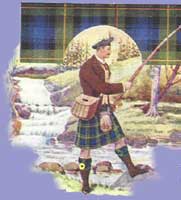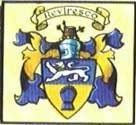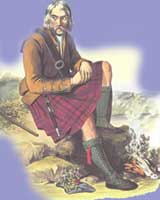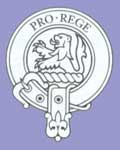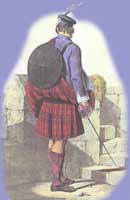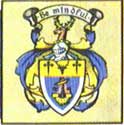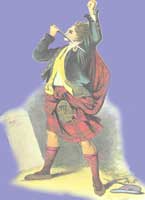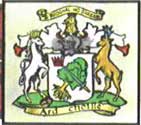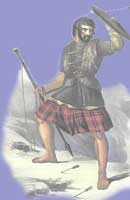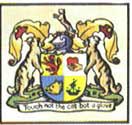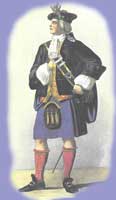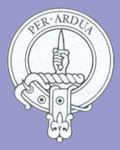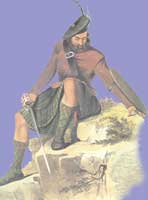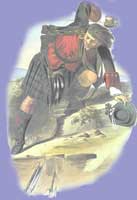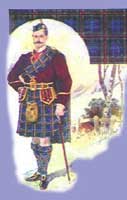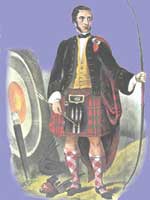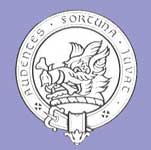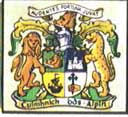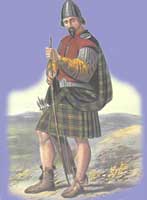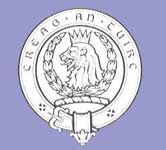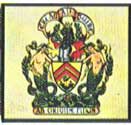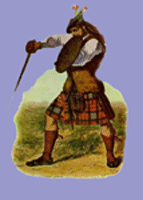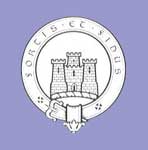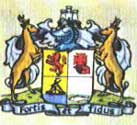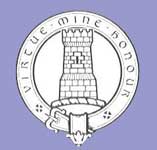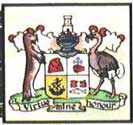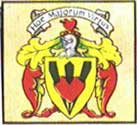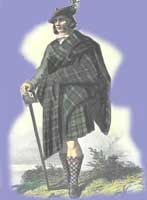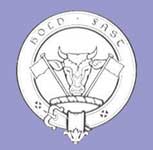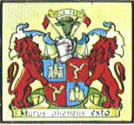Click below to find other Scottish Clans
|
|
|
| The Clans original home had been at Cowal on the rugged coastline of Glenfyne. In the year of 1750 the MacEwans Castle stood there as a ruin. If we go back into history, the first MacEwan Chief was recorded as living in the year 1200. Since that time, there have been another nine Chiefs of the MacEwan Clan. The ninth Chief was called Swene MacEwan and he was the last of the Otter Chiefs . Swene granted certain charters of Otter land to Duncan son of Alexander Campbell in the year 1431-1432. This act heralded the beginning of the transference of the MacEwan Estates to the Campbells of Argyll. |
|
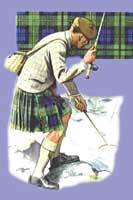 |
The MacEwans were well known as Bards and they became hereditary Bards to the Campbells of Argyll, which entitled them we are told to free land. Some of the MacEwans held dear the Jacobite cause but only as individuals because they had no Chief to call them out as a Clan. They were looked upon as Broken Highlandmen (Clanless men) according to government sources.
They were also listed in an act of parliament in 1602 along with other Clanless people as subjects of The Earl of Argyll..
|
In the year 1630, Neil MacEwan composed a Gaelic elegy on Sir Duncan Dow Campbell of Glenorchy. In Cawdor castle Argyll there is an MS. Entitled
“ Genealogy Abridgment of the Very Ancient and Notable Family of Argyll 1779”
The MacEwan Clan
Have been true to their motto, “I grow strong again” The Clan have some famous family members. Sir William MacEwan who was born in Rothesay and was a distinguished surgeon performed the first operation to remove a brain tumour in 1879.
Sir Alexander MacEwan was a noted advocate of Gaelic education; he was also Provost of Inverness. He unsuccessfully stood for parliament in the year of his death 1941. He was also elected as president of the Scottish National Party.
Unfortunately, the MacEwans are at the present time without a Chief.
The arms depicted on this page are those of MacEwan of Muckley who has not yet established his right thereto.
|
Chief: None
Clan Seat: None (originally Cowal , Glenfyne)
Plant: None
Memorials: None |
|
| Back to Top |
This Macfarlane clan came from the western banks of Scotland 's famous Loch Lomond . The clan were a Celtic people in origin. Loch Sloy at the bottom of Ben Voirlich gave them their famed war cry. The MacFarlane Clan are descended from Duncan MacGilchrist. He was recorded as being in that area of Scotland in 1296. Duncan was the brother of Mulduin Earl of Lennox , and the clan was named after his grandson Bartholomew, which in Gaelic spelt Parlan .
In 1395, Malcolm received the lands at Arrochar but unfortunately for him the male line did not materialise and he had to forfeit the land. Andrew MacFarlane succeeded the title and land in 1493, through his marriage to the daughter of the Earl of Lennox. |
|
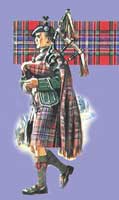 |
The battle of Flodden saw the death of Sir John MacFarlane and later Walter Macfarlane of Tarbert was killed at Pinkie in 1547.
The clan fought in the battle of Langside near Glasgow against Queen Mary. In the year of 1608, the clan were outlawed when they slew Colquhoun of Luss. The MacFarlane clan fought for Montrose in the yeas1644-1645. Major –General MacFarlane bravely captured Ischia in the Bay of Naples in 1809.
The clan members decided they would change their name and many of them moved away from their ancestral homeland. Many of the MacFarlanes settled up in the north east of Scotland in Aberdeenshire and did indeed change their family name. |
At the end of the eighteenth century the last Macfarlane Chief was said to have departed for America never to return to his native land. The Duke of Argyll took over the Macfarlane Home at Arrochar and ran it as his own. The Macfarlane Clan still claim the Chieftainship under a settlement by the last Chief of the direct line with the Duke of Argyll.
|
Chief: MacFarlane of that Ilk (Dormant)
Clan Seat: Arrochar
Plant: Cranberry
Slogan: Loch Sloy |
|
|
|
| Back to Top |
| The MacFie Clan are supposed to be descended from the race of Alpin, and are a Celtic Clan. Their Clan name in Gaelic is spelt Dubhsithe and literally means “The dark-Featured Tribe”. The English version of the Clan name became Duffie and then to MacDuffie it even became Macfie. There are several more ways to spell the clan name and here are a few: Macafee, Macfee, and Macphee. The name MacDuffyhe was recorded on the island of Colonsay in Argyll in 1549 and it was attributed to a gentle Capitane of the same island. The family of MacDuffie and MacFee were his descendents. These families held the island until the middle of
the seventeenth century. The Scottish island of Oransay became
their burial ground and the effigies on their tombstones depict
the family as either warriors or churchmen. |
|
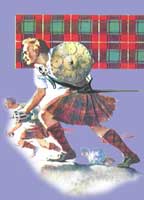 |
Malcolm MacFee of Colonsay was murdered in 1645 and Coll MacDonald and his followers were charged with Malcolm's death. These charges subsequently led to the Clan MacPhee being dispossessed. The Clan was then classified as a “Broken Clan,” and were then merged with the more powerful clans from that area. Some of the Clan People went to stay with Cameron of Lochiel, and some to the MacDonalds of Islay. Wherever the Clan People settled they became famous and conspicuous for their courage. The remainder of the clan moved to live by the Clyde and some even moved to Ireland. The people who moved to Ireland became
known as Macheffie or Macafee. The Macfies being Royalists charged
desperately along with the Cameron's at the battle of Culloden
on Drummossies bleak moor. The family motto is Pro rege and it is recorded as such in the arms of Macfie of Dreghorn.
|
Chief: Macduffie of Colonsay (Dormant)
Clan Seat: Isle of Colonsay
Plant: Pine
Slogan: Pro rege |
|
|
| Back to Top |
The Clan MacGillivray are descended from a warrior named Gillivray. They are a Celtic Clan and their stronghold was at Dunmaglass. Gillivray around the thirteenth century acknowledged himself with the famous Clan Chattan under the 5 th Mackintosh. Other MacGillivrays from Morven and Mull were said to have been a branch of the same clan at Dunmaglass. Clann Mhic Gillebhrath is the Gaelic for the MacGillivray Clan.
In a case mentioned in 1579, the names of Archibald MacIlvoray and the Laird of Luss are heard. The reverend Martin MacGillivray in 1640 on the island of Mull carried a claymore. He used this fearsome sword to threaten Maclaine of Lochbuie that he would use it if he was not paid his stipend. |
|
In the year of 1715 the MacGillivrays fought for the old Chevalier at the battle of Sherrifmuir. Lady Mackintosh had raised the clan to aid Prince Charlie but Mackintosh himself refused to lead them to battle. The clan could not operate without a leader and it was then MacGillivray of Dunmaglass took command and led them into the fight. On the day of Culloden MacGillivray fought like a lion for Bonnie Prince Charlie but was sorely wounded and lay injured in front of Cumberland 's fourth Regiment. Although alive, the next day he was brutally murdered on butcher Cumberland 's orders.
During and after the Highland clearances many of the MacGillivrays prospered by moving to America and Canada . William MacGillivray went on to be the head man in the Canadian fur business named “The North West Company”
Another MacGillivray Scottish people should be grateful to is Donald MacGillivary of Calrossies. His father built the world famous Calrossie herd of cattle so helping to preserve the Highland way of life before sheep were introduced after the Highland clearance.
|
Chief: MacGillivary of Dunmaglass (Dormant)
Clan seat: Dunmaglass, Inverness
Plant: Boxwood
Memorials: Dunlochty Kirk |
|
|
| Back to Top |
The MacGregor's are world famous for being a powerful Scottish Clan in ancient history and still so to this day. The clan claim descent from Gregor who was a son to King Alpin who ruled about 787AD. The MacGregor's were known as fierce fighting men and held their great possessions in Perthshire and Argyllshire by the liberal use of cold steel claymores.
The MacGregor war cry is rioghal mo dhream (My Blood Is Royal) The MacGregor chief fell into the hands of the English in 1296 and as a result of this his lands were passed to the Campbells. Gregor Macgregor set himself up as the Chief of Clan Macgregor, and this led to many bitter years of fighting. |
|
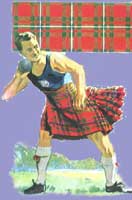 |
The Campbells set up a rival Chieftainship in 1519 and in 1552 they tried to wipe out the true line. Although the legitimate Chief and his three sons were killed a grandson survived until he too fell to the Campbells in the year of 1604.
They were so good at keeping their enemies at bay that they were decried outlaw and their name was suppressed by Parliament. In Scotland it became a criminal offence to use the name of MacGregor. The clan Macgregor occupied lands in Glenorchy during the thirteenth century, and then later they appear as tenants of the Campbells . In 1390 Patrick succeeded he had two younger brothers Gregor Macgregor of Roro in Glenlyon and John Dhu MacGregor of Glenstrae branch The Glenstrae branch ultimately won the Chieftainship. |
In 1502 the line of Roro was dispossessed by the Campbells . The MacGregor's overthrew the Colquhouns of Luss at Glenfruin thus ending their oppression, this was in 1603. This deed did not go unpunished and the MacGregor clan paid a high price for their victory. The Clan was outlawed and their Chief Alexander MacGregor and many of his followers were executed in Edinburgh , the year being 1604. The MacGregor's of Glengyle didn't disappear but were still blackmailing the Highland Borders in the year that parliament eventually annulled.
Parliament annuled the suppression of the MacGregor name in 1774.
One of the MacGregor's most famous sons has to be Rob Roy MacGregor of Glengyle. He was known as a blackmailer and cattle thief but was looked on by his own people as a benefactor. Sir Walter Scott proved that the Macgregor clan were indeed the true “Children of the Mist”. MacGregor of MacGregor and Balquhidder has been recognised as the Clan Chief and he holds a Baronetcy.
|
Chief: MacGregor of MacGregor
Clan Seat: Edinchip, Balquhidder; Glenstrae
Plant: Scots Fir
Memorials: Balquhidder Kirk
Slogan: Gregalach! |
|
|
| Back to Top |
| In 761, the Pictish King Onnust died and the Clan MacInnes can be traced to him. The name has been anglicised to Ennis or MacInnes. The first recorded reference to the name can be found in the book from the seventh century Senchus Fer nAlban (History of the men of Scotland ) The Scots had settled in this area from Ireland and in doing so split the place into three recognisable “Kindreds” (houses). The three being named as, Gabran with 560, Lorne 420 and Angus 430. Although this was not a strong fighting force they were stronger on the naval side. Each Kindred of twenty houses had to provide a seven man boat as their commitment to the security of the clan. The name of the clan in Gaelic is spelt Clan Aonghais . |
|
The Chiefs of the clan appear to have been Constables of Kinlochaline Castle In Morven and one branch was hereditary bowmen to the MacKinnons of Skye. The crest for the MacInnes clan depicts a strong arm holding a bow.
There is some evidence that suggests the MacInnes clan is kin to the Lords of Lorne. In 1645 the clan held Kinlochaline against the forces of Alisdair Maccola MacDonald (known as Colkitto, meaning left handed) the castle had been burnt to the ground as Colkitto vented his support for Montrose and Charles the first.
In the Jacobite struggles of the eighteenth century, the main body of the MacInnes clan followed the Campbell Clan supporting the Hanoverian cause against the Stewarts. Another branch of the MacInnes clan fought for the Jacobite cause with the Stewarts of Ardsheal.
With the coming of the Highland clearances the clan was scattered all over the globe, but the name is commonly found throughout the English speaking world particularly in Canada and New Zealand . Donald MacInnes who was born in Oban in 1824 moved to Canada and became a successful merchant and then a Senator. Thomas MacInnes was born in Nova Scotia and he too became a senator after a distinguished career as a physician. Rennie MacInnes went on to be Bishop of Jerusalem. Duncan MacInnes was appointed Dean of Argyll and the Isles In 1953 he was also appointed Bishop of Moray, Ross and Caithness , he died in 1970.
|
Chief: MacAonghais
Clan Seat: Kinlochaline Castle
Plant: Holly |
|
|
| Back to Top |
| The Clan is derived from the royal house of Duff and the name is not to be confused with the similar sounding clan name Mackintoshe. The Mackintosh clan are a Celtic clan and one of the clan was Chief of the Cat Confederation, Clan Chattan. Their have been recognised mackintosh Chiefs for over five hundred years. The word ‘toisech', meaning leader can also be translated as ‘captain' or ‘chief'. The Mackintosh seanachies claim that the first Mackintosh ‘Toisech' Chief was Shaw second son of Duncan Macduff, the Earl of Fife and also of the famous royal house of Dalriada. He was made Constable of Inverness castle around 1163 he was also granted some land in the Findhorn valley. The clan fought at the battle of Largs in 1263 against king Haakon of Norway sadly the fifth Chief of the Mackintosh clan was killed that day, he was called Farquhar. |
|
 |
The sixth Mackintosh Chief supported the great Scottish King Bruce in his fight for Independence from England . The Clan fought at the battle of Bannockburn in 1314 when Bruce defeated the English army which was lead by Edward the second.
Moy in Inverness is said to have become theirs in 1336.
In 1526 James Malcolmson killed Lachlan Laird of Mackintosh. The clan hunted him down and he was hacked to pieces for his brutal act. William the fifteenth Mackintosh Chief was betrayed by a woman named as the Countess of Huntly. She had lured him to her castle and then had him beheaded. |
The last clan battle took place in 1689 and was between the Mackintosh and Keppoch clans He was defeated at Mulroy by the Keppoch forces. Mackintosh died in 1704 and his son Lachlan did not produce any children by the time of his own death in 1731.
One hundred years would pass before a Mackintosh Chief would produce a son and heir to succeed them. This was put down to a jilted lover who placed a curse on the Macintosh family.
The clan fought for Montrose in support of Charles the first. The Clan remained loyal to the Stuart cause and rose in 1715 at the time of the Jacobite struggle. Lachlan Mackintosh brought eight hundred men to swell the Jacobite ranks. They were commanded by his cousin Brigadier William mackintosh of Borlum. When the defeat happened at Preston many of the Clansmen faced deportation to the Americas .
The twenty second leader and Chief of the Mackintoshes was Angus, he was a captain in the Black Watch. In 1745 his wife in his absence raised an army to aid Prince Charles Edward Stuart in his struggle for truth and the right to the Scottish Crown. The command of the men was passed to MacGillivray of Dunmaglass.
Aeneas Mackintosh was created a Baronet by King George the third but died childless. The mackintosh country is Lochaber, Strathnairn, Badenoch, and Brae. Their home, Moy Hall stands on the banks of Loch Moigh.
|
Chief: Mackintosh of Mackintosh
Clan Seat: Moy Hall, Inverness ; Dunauchton
Plant: Red Whortleberry/bearberry
Memorials: Kirk of Petty, Moray |
|
|
| Back to Top |
| The original location for the Macintyre clan is Glen Noe. The clan name spelt in Gaelic is Mac an t-Saoir (meaning son of the carpenter) and dates from the early twelfth century. It is interesting to note how this name came about. Somerled was trying to win the battle to be Lord of the Isles and had enlisted his nephew Macarill's help to try to win the hand of King Olav's daughter. The nephew held the King to ransom by drilling holes in the hull of his galley and only agreeing to fix them when he had what he required. The King had no option but to agree to his terms. Macarill was known from then as the ‘Wright' or ‘Carpenter' This deed further endeared him to his uncle who was now Lord of the Isles. |
|
The clan occupied lands in the area since the twelfth and thirteenth centuries. The Macintyre Clan is traditionally known as a sept of the MacDonalds of Sleat. The same lands they held from the Campbells of Glenorchy (later to be Bredalbane) and did indeed hold them until 1806. The first Chief of Glen Noe Duncan Macintyre married Mary a daughter of Patrick Campbell of Barcaldine. Donald and Mary went on to have a son Donald. When Donald married, he produced three children James the eldest in 1727. When his father died, James succeeded as the third Clan Chief.
During the Jacobite struggle of 1745, James would have liked to aid his rightful King by assisting Charles Edward Stewart when he raised his father's standard at Glenfinnan. James was married to a Campbell and his neighbours were of the same clan so it made it very difficult for him to take the Jacobite side. However many of his clansmen did slip away and joined Bonnie Charlie to fight with the Stewarts of Appin at the battle of Culloden.
When James died Donald who was a Doctor in turn succeeded him, he became fourth chief of the Macintyre Clan in Glen Noe. The third son Duncan was a captain in a Highland regiment and was indeed the last Macintyre of Glen Noe. Doctor Donald Macintyre emigrated to America in 1783 as his Campbell landlords had steadily upped the rental of his home and lands. James and his The Campbell now wanted cash rent instead of the symbolic rent of the past. His brother Duncan kept on the lands until 1806 when he too was forced to leave Glen Noe for the last time. The Clan and the Chief kept the line and preserved it in America . They had the armorial great seal, signet ring, and quaffing cups.
In 1991 the Lord Lyon Formally recognised James William Macintyre of Glen Noe the ninth recorded Chief of the Macintyre Clan. He was also admitted to the standing council of Scottish Chiefs.
|
Chief: James William Macintyre
Clan Seat : None
Plant : Unknown |
|
| Back to Top |
The Gaelic name for this clan is spelt Macaodh and means ‘son of Hugh' Unfortunately the ‘Hugh' is uncertain. It may be the case that the name comes from the ancient Celtic royal house. Aodh or Hugh was the abbot of Dunkeld and the first Earl of Fife. He was also elder brother to Alexander the first.
It is more commonly accepted that the clan originates from a branch of the Royal House of Moray probably deriving its style from the Morgund of Pluscarden who was a prince to the House of Moray. The earliest Gaelic charter extant was granted by Donald Lord of the Isles to Brian Mackay in 1408 |
|
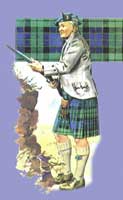 |
The first chief who has been recorded historically is Angus Du or Dubh Macaodh; he was born in1380 and was assassinated in 1429. He had been married to Elizabeth sister of Donald Lord of the Isles, and granddaughter of Robert the second. Angus was recorded as being an immensely powerful figure and at one time had access to 4,000 men at arms. On his death the clan's rightful heir had been held captive on the Bass rock and the clan was ruled by the dead chief's younger brother until 1437 when he managed to escape his bonds and return home. His son became chief and was involved in the bitter and cruel fight at Blair Tannic, Caithness . |
The Mackay clan occupied the most remote part of Scotland , and was further from Government law than any other part of the country. Its land stretched from the bleak Cape Wrath along the northern coast to the borders of Caithness . Its southern borders were magnificently defended by the majestic mountains and the bleak featureless uplands. Towards the end of the sixteenth century, the Mackay clan were becoming dependant on their neighbouring clan, the Earls of Sutherland, so they sought a better future as soldiers on the European continent.
The Mackay Regiments were famous for their prowess at fighting and were at the forefront of the ‘Thirty year war'.
The majority of their estates were sold off to afford this great exploit to fight for the protestant cause abroad. 2,000 men who had been recruited by Lord Reay had to be transported and maintained as a fighting machine. Donald Mackay their Commander was made a Baronet of Nova Scotia on 28 th of March 1627. A year later, he was elevated to the peerage as Baron Reay. He was a staunch supporter of Charles the first and was to have received an earldom from the monarch after the civil war. Unfortunately, for Reay the Royal patent was not completed and he spent his final days exiled in Denmark .
|
Chief: Lord Reay
Clan Seat: House of Tongue, Sutherland
Plant: Great Bulrush
Memorials: Kirk of Tongue |
|
| Back to Top |
The MacKenzie name spelt in Gaelic is ‘Maccoinneach' meaning ‘son of the bright one' it has been suggested by some people that the name derives from the pagan god Cernunnos. This God was usually depicted in the form of a stag's head or a set of antlers. The Chiefs shield sports a stag's head, which could be an explanation for this emblem. The clan is of Celtic origin. They rose to power as a clan under a great warrior chief, Alexander Ionraech , seventh Chief of Kintail. He ruled during the year1427.
The first of the clan to make an impact on Highland history was named Alisdair MacKenzie. He did not appear on the historic scene until the fifteenth century. |
|
 |
He was one of the people summoned to meet James the first in 1427. He lived until 1488. During his lifetime, he supported the crown against The Lord of the Isles and was rewarded for this by being given title to lands.
There was Ian MacKenzie who fought at the battle of Flodden in 1513 and at Pinkie in 1547; he had managed to escape with his life on both occasions. He lived to see Mary Queen of Scots return to her Kingdom in 1561 but died later that year. John MacKenzie was to go on to fight for Mary Queen of Scots at the battle of Langside near Glasgow . |
The Mackenzie Clan was flourishing and their land stretched from The Black Isle to the Outer Hebrides . In 1609, their Chief was raised to the peerage as Lord MacKenzie of Kintail. His son Colin became Earl of Seaforth in 1623.Sir Roderick MacKenzie founded the line that created Baronets in 1628, and later became Earls of Cromarty.
The family were supporters of the Stuarts, and Seaforths fought for James the eighth at the battle of the Boyne in 1690. His exiled King raised the fifth earl already a Knight of the Thistle to Marques.
William the fifth earl was forfeited as a supporter of the Jacobite Struggle in 1715, which meant that he lost his lands and titles. The Earls of Cromarty were also loyal Jacobite supporters and the third earl George fought at the battle of Falkirk . He and his son were later captured at Dunrobin castle in April 1746, and the Earls titles were forfeit. The Estates but not the titles were returned.
The last Seaforth Chief to hold a Peerage was James Stewart-MacKenzie, Lord Seaforth of Brahan in 1921. The Highlander sketched at the side, depicts an officer of the Seaforth Highlanders in 1780. Gairloch is at present acting as the Seaforth “Commander of the Clan”.
|
Chief: MacKenzie of Kintail
Clan Seat : Brahan Castle , Urray, Ross-shire ; Eilean Donan Castle , Lochalsh
Plant: Deers grass
Memorials: Rosemarkie in Ross |
|
| Back to Top |
There is no very definite account for this clan and even less information available. According to the earliest account of the Clan MacKinlay name, they may have been derived from Lennox but this is not certain. The name MacKinlay is numerous about that area even to this very day. The MacKinlay chief sept is stated by some people as being descended from, Finlay Buchanan of Drumikil. This however cannot be proven and it leaves the clan open to other interpretations.
The MacKinlays supposedly moved to Ireland during the “Plantations” along with other Scottish Clans. The name changed with the moving to another country and we began to see the spelling becoming Mackinlay and MacGinlay. |
|
|
Clan members who moved across the vast Atlantic Ocean saw their family name change to MacKinley. In fact the famous mountain in Alaska is named after this branch of the MacKinlay family.
The MacKinlays are mentioned in history several times round about the Dumbarton and Luss area from 1527 until 1624. There is no recorded entry of any person or clan called MacKinlay taking part in the Jacobite Struggle of 1745-1746.
It is a common mistake for people to associate the Clan MacKinlay as being ancestors of Fionnlagh Mor progenitor of the Farquharsons of Braemar, but this is another connection which cannot be proven to satisfaction. |
It would appear to be more likely that the clan is more associated with and indeed embraces some of the Macleay clan. At one time in Dumbarton and surrounding areas there was a people called Mac-An-leighs, and further north were the Mac-On-leays the Real Macleays.The fact that some of the MacKinlays changed their name to the “Ley” adds some weight to this argument. There are another Scottish family involved in the name of Macleay and that is Livingston . It is much more likely that the MacKinlay Clan are derived from this family. A grant appears to have been given to Charles MacKinlay of Kynachan in Perthshire to use the un-differenced arms of the MacKinlay Chief and still may be regarded as such.
|
Chief: Not known
Clan Seat: Not known
Plant: Not known
Memorials: Not known |
|
| Back to Top |
The MacKinnon Clan are a branch of the great siol alpin a Celtic Clan and the descendents of the famous historical figure: Kenneth Macalpin who ruled Scotland in the ninth century.
During the years when Robert the Bruce was being pursued the MacKinnon Clan on Arran gave him shelter and aided his journey to Carrick. After the battle of Bannockburn on the 26 th of June 1314 when the Scottish army defeated the might of the English Edward the second, Bruce rewarded their friendship by giving them lands in Skye. Another branch of the Clan became hereditary abbots of Iona , Scotland 's most Holy Island . |
|
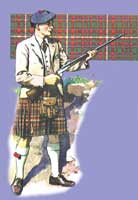 |
The last Abbot was John Mackinnon who died around the end of 1500. Pabay is an island situated off the coast of Skye , and it was here that the name MacKinnon was mentioned in 1594 as a family of that name were reported to be sheltering there.
n 1606 Lord Ochiltree was sent to Mull to make proposals to the Island Chiefs. The Chiefs disagreed with the offers that were put forward and they were seized and imprisoned on the mainland prisons. Lachlan MacKinnon and other Chiefs lay in Prison for three years before they gave in and signed the “Iona Statutes” which placed many restrictions on their power. Despite this set-back the MacKinnons were loyal to the Stuarts and fought for Montrose at Inverlolochy in 1645 and at Auldearn. |
In 1650 the Clan Mackinnon fought for Charles the second at Worcester . Their leader and Chief was the young Lachlan Mor. He was honered by being made a Knight Banneret by the King himself on the field that very day. Many Scots were killed that day and Cromwell went on to rule the country with Charles the second fleeing abroad.
The Clan continued their support for the Jacobite cause and again raised men (150) to fight along side the Earl of mar in 1715 at the Battle of Sheriffmuir. Their Chief was declared forfeit for this act of treason. The MacKinnons were “Out” again in 1745 marching to Edinburgh to meet up with Charles Edward Stewart. They also fought at the disastrous battle of Culloden, when the Jacobite army was defeated.
The MacKinnons aged Chief was arrested and put on trial for joining the Jacobite struggle. He was held at Tilbury Fort at the mouth of the Thames , but released due to his age and ill health. When the Kings clemency was explained to the old Chief he replied “Had I the King in my power I would return the compliment and send him back to his own country” He died in 1756. Unfortunately for the MacKinnons they had to sell a twenty six mile long valley of Strathairdale in 1765. The last of their lands were sold in 1791. John the last Clan Chief of the great Clan Fingo died in poverty when he inherited nothing but his title.
|
Chief: MacKinnon of MacKinnon
Clan Seat: Strathdardal, in Skye
Plant: St. John's Wort
Memorials: Iona |
|
| Back to Top |
The Maclarens are an ancient Celtic Clan and are derived from the hereditary Abbots of Achtow in Perthshire .There is another idea that the clan may have originated in Argyll, Tiree to be exact. It was said there that they descended from Lorn, son of Fergus MacErc. However the eponymous ancestor is more likely to be the Abbot Lawrence of Achtow.
Their domain was Lochearnhead and Glengyle. Their name appears on the “Ragman's Roll” signed at Berwick in 1296. Three of their family had to take an oath of loyalty to Edward the first of England . It is thought that the Maclarens fought at Bannockburn under the standard of Malise, Earl of Strathearn. |
|
 |
The Maclarens lost their home at Balquhidder when the last Celtic earl of Strathearn was deprived of his title in 1344.
The Maclarens were allies with the Stewarts of Appin through a love-at-first-sight encounter. Their feuds were frequent with the Buchanans, Campbells and MacGregor's. The clan fought at Flodden in 1513 and at Pinkie in 1547.
The MacLarens fought with Montrose in support of Charles the first in 1645, at the Battles in Inverlochy, Auldearn, Alford and Kilsyth. At the end of the century (1689) they again gave their support by joining Viscount Dundee at the battle of Killiecrankie. |
The son of the Reverend John MacLaurin Minister of Glendaruel translated the psalms into Gaelic. His name was Colin MacLaren or MacLaurin; he was born at Kilmodan in 1698. He was also Professor of Mathematics at Edinburgh University in 1745. He had planned the defence of the city against the Jacobite Prince Charles Edward Stuart. When the Jacobite army arrived he had to flee for his life.
At the ill-fated battle of Culloden they (MacLarens) were on the right of the line with Lord George Murray brother to the Duke of Athol. Donald MacLaren was captured and it was not long until Cumberland 's troops were at the gateway of Balquhidder which they proceeded to ravage. Donald was held in Edinburgh but had to go to Carlisle for trial, on the way there he managed to escape by jumping down a dangerous gorge and escaping the searching Redcoats. He was still in Balquhidder at the amnesty of 1757.
The Clan burial place is at Leackine by Lochearnside. The Lyon Court adjudged that the House of MacLaren of Auchleskine become Chiefs and heir to MacLaren of MacLaren. This event happened in 1957. The Clan Chiefs have recently been able to get part of their lands back including the clan heartland Creag an Tuirc. Translated means ‘The Boars Rock'
|
Chief: MacLaren of MacLaren
Clan Seat: Auchleskine and Achtow in Balquhidder, Perthshire
Plant: Laurel
Memorials: Balquhidder Kirk |
|
| Back to Top |
CLAN MACLACHLAN / MACGLAUGHLAN |
Tradition tells us that the clan originates from the High Kings family in Ireland . Their name was O'Neil. The family had been High Kings since the days of ‘Niall of the nine hostages' It is said that this family has the oldest traceable history of any family in Europe . The family name is first mentioned in 400AD. They are a Celtic Clan with ancient roots. The name has been known in Scotland since the days of the great warrior Lachlan Mor who is recorded as living on the banks of Loch Fyne in 1292.
The MacLachlans of that Ilk have lived in Strathlachlan in Argyllshire since time immemorial. |
|
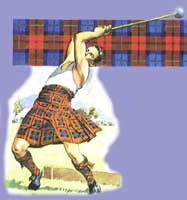 |
The family are included in the Sheriffdom as being in that area in the late twelve hundreds. MacLachlans were granted a charter by King John Baliol and their name appears on the Roll of Magnates of Scotland who sat in the very first Parliament of Robert Bruce at Saint Andrews in 1308.
The family fought with distinction at the Battle of Bannockburn, when the Scottish army led by the great Bruce defeated a much larger English army commanded by Edward the second. |
The MacLachlans realised that to make their clan stronger financially, and also in a military sense stronger they had to amalgamate with another Clan. The MacLachlans decided to join forces with their nearest neighbours who were the Campbells . The clan successfully applied this and it was beneficial to all. The two families married into each other and took on common tasks. Lachlan MacLachlan was Chief in 1536 when he accompanied the Earl of Argyll to France for the marriage of James the fifth to Madeline of Valois.
The MacLachlan clan thrived and were working over thirty farms in Strathlachlan and Loch Fyne. In the year 1680 they were elected into a free barony before the massive hazards of the 1688 revolution. The clan almost assuredly fought at the battle of Killiecrankie in 1689.
The MacLachlan Clan remained loyal to the Jacobite cause and came “out” for the old Chevalier in 1715. The family remained loyal to the Stuart cause and Lachlan MacLachlan the seventeenth Chief, the direct descendent of Lachlan Mor brought his men to the Jacobite struggle in 1745. Lachlan was declared A.D.C. to Bonnie Prince Charlie. The clan as a whole supported Prince Charles Edward Stuart in his struggle for justice, and fought bravely at Culloden. The reverend John MacLachlan was of Kilchoan was Chaplain-General to the Jacobite army.
Their homeland was ravaged by Cumberland 's barbaric troops soon after the battle was lost. The castle was bombarded from the sea into a ruin. Lachlan MacLachlan was killed in the battle and it is said that his horse which had run free eventually made it home.
Due to his death and with help from the Campbells the clan were let of very lightly for their involvement in the Jacobite cause. The family were allowed to rebuild their castle and it stands until this day on the same spot as before.
|
Chief: MacLachlan of MacLachlan
Clan Seat: Castle Lachlan , Strathlachlan, Argyll
Plant: Rowan
Memorials: None |
|
| Back to Top |
The famous Gillean of the Battleaxe, the Gaelic spelling of the name is Gilleathan Na Tauidh, lived in Mull and was the originator of the Celtic Clan Maclean of Duart. The clan name in Gaelic is MacGille Eoin (Son of the servant of St. John ) Gillean fought at the battle of Largs in 1263 against the army of Haakon the fourth. When the defeated Vikings surrendered everyone knew it was the end of the Norse domination in that part of the world. Gilleans Great Great Grandson settled in Mull and prospered.
The Maclean family became vassals of The Lord of the Isles. In 1411 Lachlan Lubanach's son ‘Red Hector of the Battles' fought for his lord at Harlow . Sir Alexander Irvine had fought Red Hector in single combat and both had been seriously wounded though neither man appeared to win. Shortly after the fight they both died from their terrible injuries. |
|
 |
In the year of 1476 because The Lord of the Isles had been dispossessed the Maclean clan were no longer under any obligation to him. By the end of that century the Maclean Clan owned most of Mull , Jura, Tiree, Islay and Knapdale.
At the battle of Flodden in 1513 Lachlan of Duart was killed along with his King.
There was no love lost between the Macleans and the MacDonalds. The Macleans joined with their Protestant Faith counter-parts the Clan Campbell to do their worst to the MacDonalds of Islay. |
The MacDonalds were harried all over the island and after much carnage decided to leave their home for good. The consequences of this were that the Macleans and the MacDonalds in the year of 1594 were declared outlaw by the Privy Council. Nova Scotia was to make Sir Lachlan Maclean a baronet on the third of September 1631 . Lachlan was devoted to his King and called his clan out to join Montrose to support Charles the first in the year of 1645. Sir Lachlan Maclean died in 1649 and was succeeded by his son Sir Hector Maclean. At the battle of Inverkeithing in 1651 Sir Hector Maclean lost his own life. The Macleans were loyal to their King and the fifth Baronet Sir John Maclean hurried to the standard and fought at the battle of Killiecrankie in 1689. When the 1715 Jacobite army was being formed the Macleans were there with their Baronet Hector. He was given a Jacobite Peerage the same year. He stayed in Edinburgh to try and organise the 1745 Jacobite struggle but was imprisoned for his efforts. He died in Rome in 1750.
Maclean of Drimmin led the Clan throughout the whole of the campaign but was killed at the battle of Culloden in the year 1746.
Duart castle had fell into ruin but was reclaimed in 1911 by the Chiefs and has been restored as the family seat.
|
Chief: Maclean of Duart
Clan Seat: Duart castle, Mull
Plant : Crowberry
Memorials: None |
|
| Back to Top |
| The Maclennan or Logan clan are a Celtic people. After a battle near Inverness at a place called Drumderfit a warrior named Gilligorm was killed in the fierce fighting with the Fraser clansmen. With him was his pregnant wife. When the child was born it was found to be deformed. Some say that the Frasers deliberately damaged the child but there is no proof of this. The boy grew well despite his deformity and became a Celtic Priest. His name was Crotair MacGilligorm. The Priest went on and founded a church at Kilmuir, in Skye and another at Glenelg. As he was a priest of the Celtic Church he was free to marry and took the opportunity to do this. The Celtic priest had a son called Gille Fhinnein and it is from this person that the clan Maclennan originates. |
|
 |
It is thought that the Maclennan clan were at one time custodians of Eilean Donan castle because of their closeness with the Clan Mackenzie. The Earl of Seaforth played a huge part in the lives of the Maclennan Clan. Many clans had been asked to support Charles the first in 1645 but the Maclennan clan were on the Covenanters side because of their allegiance with the Mackenzie clan. At the battle of Auldearn the Maclennan Chief was Ruaridh who was a red headed giant of a man and stood well over six feet tall, he carried Lord Seaforths standard. Montrose pulled a ruse which worked well and he turned the Seaforth flank. The Maclennan warriors were ordered to retreat but the word never got to them and every man died protecting the Seaforth standard. |
There are very few records of any Maclennan involvement with the Jacobite struggle of 1715 and the last one to date 1745/46. It is known that some Macleans were taken prisoner after the bitter battle of Culloden, on the day that Scotland died. Ronald Maclennan has more recently been recognised by the Lord Lyon, King of Arms as being Chief of this name under the process of selection known as the
‘Ad hoc derbhfine' although he was not a blood line member of the Maclennan Chieftain stock, he was a member of the Maclennan family who had matriculated arms since 1672.
The Crest is not the MacLennan but the Logan.
|
Chief: ( Logan ) Logan of Drumderfit
Clan seat: Drumderfit, Ross-shire (Black Isle)
Plant : Furze
Memorials: None |
|
| Back to Top |
| Olaf the Black was one of the last Norse Kings. He ruled over the North Isles and of Man. He had a sons and the youngest was called Leod. Olaf died around 1237 and Leod inherited the islands of Lewis and Harris. Leod married a daughter of the Norse seneschal or Steward of Skye brought the family to live at Dunvegan. To this modern day it remains the Macleod Chiefs seat. The MacLeod clan consist of mainly twp branches. We have the MacLeods of Lewis (named after a grandson ‘lews') and the MacLeods of Skye (named after another relation Tormod) who established their seat at Dunvegan. Tormod received Glenelg from King David the second under charter in 1334. His descendents went on to own vast areas of Skye and St. Kilda. |
|
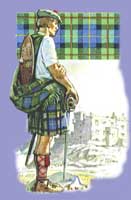 |
The MacLeods fought beside the Macdonald Lord of the Isles to the battle of Harlaw in 1411. However James the fifth had a score to settle with the MacDonalds who were friendly with the MacLeods. The family managed to steer clear of the worst trouble between the two factions.
The MacLeods managed to come out of the argument on the winning side. In 1542 Aliasdair Crotach the eighth Dunvegan Chief ‘Hump back' secured a title to Trotternish, which had been the subject of a long running dispute with the MacDonalds of Sleat. Alasdair Crotach is responsible for two of the finest Monuments in the Hebrides . The Famous Fairy tower at Dunvegan was built at his command as was the Church at Rodel where he was later entombed, two of the most notable structures in Scotland . |
In 1557 the entire population of Eigg were suffocated in a cave by MacLeod of Dunvegan. The fifteenth Chief was to be Ruaraidh Mor in 1595. He had already been knighted by James the sixth and continued the work of his predecessor Alasdair Crotach to turn Dunvegan into the very best cultural centre in the islands. A great drinking horn has been named after the fifteenth Chief and is used when a new chief is being installed as a right of passage the Chief has to drink from the horn which holds a bottle and a half of claret. He has to drink this without ‘setting down or falling down'
In the year 1597 the Barony was passed over to Sir Rory Mackenzie when Torquil MacLeod was killed.
The MacLeods never got involved in any of the Jacobite struggles and did not come ‘out' in 1715 or in 1745. They had been supporters of Charles the first in 1645 and had lost seven hundred men at the Battle of Worcester.
In 1988 Torquil MacLeod of Raasay rematriculated his arms to be recognised by the Lord Lyon as Macleod of the Lews, ‘Chief and head of the Baronial house under the Macleod of MacLeod. Dunvegan Castle has been completely restored and is still occupied by the Macleod of Macleod.
|
Chief: Macleod of MacLeod
Clan Seat : Dunvegan Castle , Isle of Skye
Plant: Juniper
Memorials: Rodill, in Harris |
|
Click below to find other Scottish Clans
|
|
Back to Top
|

